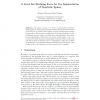Free Online Productivity Tools
i2Speak
i2Symbol
i2OCR
iTex2Img
iWeb2Print
iWeb2Shot
i2Type
iPdf2Split
iPdf2Merge
i2Bopomofo
i2Arabic
i2Style
i2Image
i2PDF
iLatex2Rtf
Sci2ools
105
Voted
CAIP
2007
Springer
2007
Springer
A Level Set Bridging Force for the Segmentation of Dendritic Spines
The paper focusses on a group of segmentation problems dealing with 3D data sets showing thin objects that appear disconnected in the data due to partial volume effects or a large spacing between neighbouring slices. We propose a modification of the speed function for the well-known level set method to bridge these discontinuities. This allows for the segmentation of the object as a whole. In this paper we are concerned with treelike structures, particularly dendrites in microscopic data sets, whose shape is unknown prior to segmentation. Using the modified speed function, our algorithm segments dendrites and their spines, even if parts of the object appear to be disconnected due to artifacts. 1 Motivation A number of problems arise when an object in a 3D data set should be segmented. Depending on the modality there may be certain artifacts, e.g. magnetic field inhomogeneities in MR-images or metal artifacts in CT-images. An artifact common to almost all image acquisition technique...
| Added | 07 Jun 2010 |
| Updated | 07 Jun 2010 |
| Type | Conference |
| Year | 2007 |
| Where | CAIP |
| Authors | Karsten Rink, Klaus D. Tönnies |
Comments (0)

